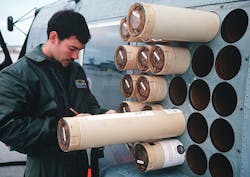Navy orders pinging active sonar ASW sonobuoys to locate and track stealthy enemy submarines
Officials of the Naval Air Systems Command at Patuxent River Naval Air Station, Md., announced a $20.4 million contract modification Monday to ERAPSCO in Columbia City, Ind., to provide as many as 5,000 AN/SSQ-125 sonobuoys, which are dropped from Navy fixed-wing ASW aircraft and helicopters.
Sonobuoys enable Navy ASW forces to detect, track, and pinpoint potentially hostile submarines operating in the open ocean that could be threats to Navy carrier battle groups or other forces. Information from these systems can help enable precision attacks with air-launched torpedoes.
The SSQ-125 multi-static coherent source sonobuoy is a sound source in a multistatic sonobuoy field. It can generate a variety of waveforms, and is designed to work with the AN/SSQ-53F, AN/SSQ-77C, and AN/SSQ-101 sonobuoys.
The AN/SSQ-125’s RF channel can be programmed to any of the standard sonobuoy operating channels. At any time after deployment, the AN/SSQ-125 can be commanded to change its operating parameters or depth (deeper only), generate a ping, or scuttle.
The AN/SSQ-125 pinging sonobuoy works together with the AN/SSQ-53F sonobuoy, which listens for returns from the SSQ-125's pings with four hydrophones -- each one a multichannel directional piezoelectric ceramic transducer -- that operate at depths of 90, 200, 400, and 1,000 feet.
Aircraft can drop a pattern of the SSQ-53F listening sonobuoys, which relay information back to the aircraft by radio link, to determine the exact locations of enemy submarines.
The SSQ-53F has three sensors: a constant shallow omni (CSO), an advanced directional low frequency analyze and record (DIFAR) sensor, and a calibrated wideband omni. The buoy digitally conditions and amplifies the acoustics and provides directional data that helps establish azimuthal bearing to the submarines being tracked.
The AN/SSQ-77C vertical line array directional frequency analysis and recording (VLAD) sonobuoy, also is a passive listener designed with beamforming technology to increase the detection of signals of interest in an environment where there is an ever-increasing amount of ambient noise.
Related: Navy seeks to enhance undersea surveillance to optimize anti-submarine warfare operations
The AN/SSQ-101 air deployed active receiver (ADAR) sonobuoy provides a commandable passive search capability, and functions as the receiver in a multistatic active receiver system. The device uses a pentagon-shaped horizontally oriented pattern of hydrophones to detect and beamform underwater sound waves.
Monday's deal is a modification of an original $166 million contract the Navy awarded to ERAPSCO in July 2014 to provide 141,263 AN/SSQ series sonobuoys, and 5,000 MK-84 signal underwater sound devices. The Navy awarded a separate $195.2 million modification to the original contract last November for as many as 141,500 AN/SSQ series sonobuoys and 10,000 MK-84 signal underwater sound devices.
ERAPSCO Inc operates as a joint venture between the Sparton Corp. Defense & Security segment in Le Leon Springs, Fla., and Ultra Electronics USSI in Columbia City, Ind. The company will split the work on this contract modification between facilities in DeLeon Springs, Fla., and Columbia City, Ind., and should be finished by October 2017.
For more information contact ERAPSCO online at http://erapsco.com, Sparton Defense & Security at http://sparton.com, Ultra Electronics USSI at www.ultra-ussi.com, or Naval Air Systems Command at www.navair.navy.mil.
